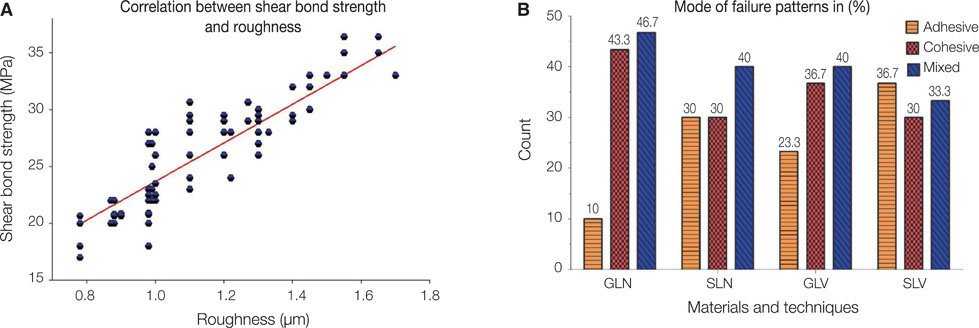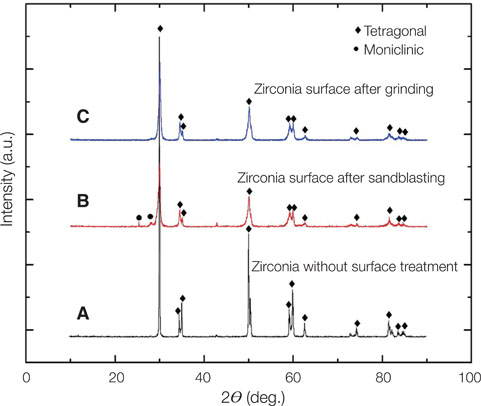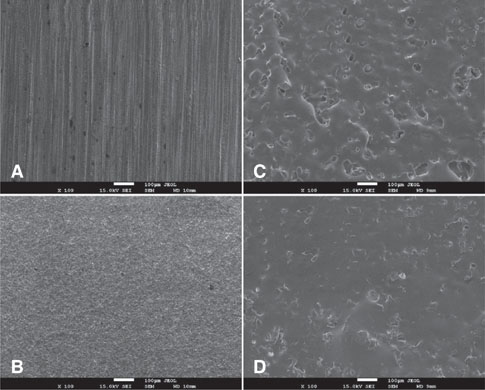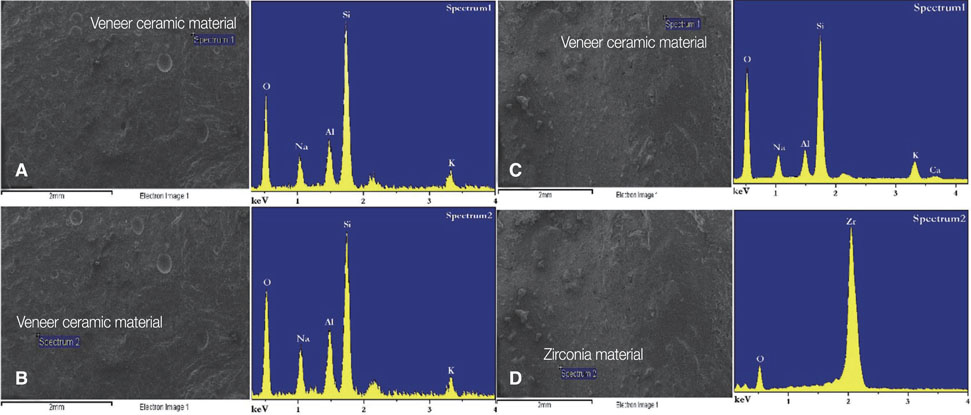J Adv Prosthodont.
2019 Feb;11(1):65-74. 10.4047/jap.2019.11.1.65.
Effects of different surface treatments on the shear bond strength of veneering ceramic materials to zirconia
- Affiliations
-
- 1School and Hospital of Stomatology, China Medical University, Shenyang, Liaoning Province, PR China. liuyi@cmu.edu.cn
- 2School of Environmental and Chemical Engineering, Dalian University, Dalian, Liaoning Province, PR China.
- 3School of Clinical Dentistry, the University of Sheffield, Sheffield, United Kingdom.
- KMID: 2438933
- DOI: http://doi.org/10.4047/jap.2019.11.1.65
Abstract
- PURPOSE
To evaluate and compare the effect of different materials and techniques on the shear bond strength of veneering ceramic materials to zirconia.
MATERIALS AND METHODS
136 sintered zirconia cubes were prepared and randomly divided into four study groups according to corresponding methods of surface treatment and materials: GLN (grinding followed by laser scanning using Noritake Cerabien ZR), SLN (sandblasting followed by laser scanning using Noritake Cerabien ZR), GLV (grinding followed by laser scanning using VITA VM 9), and SLV (sandblasting followed by laser scanning using VITA VM 9). Spraying technique was performed to coat the core. Profilometer, SEM, XRD, EDS, universal testing machine, and stereomicroscope were used to record surface roughness Ra, surface morphology, phase transformation, elemental compositions, shear bond strength SBS values, and failure types, respectively. Specimens were investigated in unaged (not immersed in artificial saliva) and aged (stored in artificial saliva for a month) conditions to evaluate SBS values.
RESULTS
Grinding and GLN as first and second surface treatments provided satisfactory Ra values in both conditions (1.05 ± 0.24 µm, 1.30 ± 0.21 µm) compared to sandblasting and other groups (P < .05). The group GLN showed the highest SBS values in both conditions (30.97 ± 3.12 MPa, 29.09 ± 4.17 MPa), while group SLV recorded the lowest (23.96 ± 3.60 MPa, 22.95 ± 3.68 Mpa) (P < .05). Sandblasting showed phase transformation from t-m. Mixed failure type was the commonest among all groups.
CONCLUSION
GLN showed to be a reliable method which provided satisfactory bond strength between the veneer ceramic and zirconia. This method might preserve the integrity of fixed dental crowns.
Figure
Reference
-
1. Her SB, Kim KH, Park SE, Park EJ. The effect of zirconia surface architecturing technique on the zirconia/veneer interfacial bond strength. J Adv Prosthodont. 2018; 10:259–264.
Article2. Gehrke P, Tabellion A, Fischer C. Microscopical and chemical surface characterization of CAD/CAM zircona abutments after different cleaning procedures. A qualitative analysis. J Adv Prosthodont. 2015; 7:151–159.
Article3. Eisenmenger-Sittner C, Nöbauer C, Mozetic M, Kovač J, Zaplotnik R. Stabilization of tetragonal ZrO2 by oxygen plasma treatment of sputtered ZrCu and ZrAl thin films. Surf Coat Technol. 2018; 347:270–277.
Article4. Ural Ç, Külünk T, Külünk Ş, Kurt M. The effect of laser treatment on bonding between zirconia ceramic surface and resin cement. Acta Odontol Scand. 2010; 68:354–359.
Article5. Mosharraf R, Rismanchian M, Savabi O, Ashtiani AH. Influence of surface modification techniques on shear bond strength between different zirconia cores and veneering ceramics. J Adv Prosthodont. 2011; 3:221–228.
Article6. Abd El-Ghany OS, Sherief AH. Zirconia based ceramics, some clinical and biological aspects: Review. Future Dent J. 2016; 2:55–64.
Article7. Yamaguchi H, Ino S, Hamano N, Okada S, Teranaka T. Examination of bond strength and mechanical properties of Y-TZP zirconia ceramics with different surface modifications. Dent Mater J. 2012; 31:472–480.
Article8. Tarib NA, Anuar N, Ahmad M. Shear bond strength of veneering ceramic to coping materials with different pre-surface treatments. J Adv Prosthodont. 2016; 8:339–344.
Article9. Cho JH, Kim SJ, Shim JS, Lee KW. Effect of zirconia surface treatment using nitric acid-hydrofluoric acid on the shear bond strengths of resin cements. J Adv Prosthodont. 2017; 9:77–84.
Article10. Khayat W, Chebib N, Finkelman M, Khayat S, Ali A. Effect of grinding and polishing on roughness and strength of zirconia. J Prosthet Dent. 2018; 119:626–631.
Article11. Miyazaki T, Nakamura T, Matsumura H, Ban S, Kobayashi T. Current status of zirconia restoration. J Prosthodont Res. 2013; 57:236–261.
Article12. de Lima E, Meira J, Ozcan M, Cesar P. Chipping of veneering ceramics in zirconium dioxide fixed dental prosthesis. Curr Oral Health Rep. 2015; 2:169–173.
Article13. Marefati MT, Hadian AM, Hooshmand T, Yekta BE, Koohkan R. Wettability of zirconia by feldspathic veneer in dental restorations: Effect of firing atmosphere and surface roughness. Ceram Int. 2018; 44:4307–4312.
Article14. Koenig V, Vanheusden AJ, Le Goff SO, Mainjot AK. Clinical risk factors related to failures with zirconia-based restorations: an up to 9-year retrospective study. J Dent. 2013; 41:1164–1174.
Article15. Agustín-Panadero R, Román-Rodríguez JL, Ferreiroa A, Solá-Ruíz MF, Fons-Font A. Zirconia in fixed prosthesis. A literature review. J Clin Exp Dent. 2014; 6:e66–e73.
Article16. Soon G, Pingguan-Murphy B, Lai KW, Akbar SA. Review of zirconia-based bioceramic: Surface modification and cellular response. Ceram Int. 2016; 42:12543–12555.
Article17. Kasraei S, Atefat M, Beheshti M, Safavi N, Mojtahedi M, Rezaei-Soufi L. Effect of surface treatment with carbon dioxide (CO2) laser on bond strength between cement resin and zirconia. J Lasers Med Sci. 2014; 5:115–120.18. Shukla PP, Lawrence J. Evaluation of fracture toughness of ZrO2 and Si3N4 engineering ceramics following CO2 and fibre laser surface treatment. Opt Lasers Eng. 2011; 49:229–239.
Article19. Mirhashemi A, Sharifi N, Moharrami M, Chiniforush N. Evaluation of different types of lasers in surface conditioning of porcelains: A review article. J Lasers Med Sci. 2017; 8:101–111.
Article20. ISO 4288. Geometrical Product Specifications (GPS)-Surface Texture: Profile method-Rules and procedures for the assessment of surface texture. Geneva; Switzerland: International Standards Organization (ISO);1996.21. Kirmali O, Akin H, Ozdemir AK. Shear bond strength of veneering ceramic to zirconia core after different surface treatments. Photomed Laser Surg. 2013; 31:261–268.
Article22. Wang G, Zhang S, Bian C, Kong H. Effect of zirconia surface treatment on zirconia/veneer interfacial toughness evaluated by fracture mechanics method. J Dent. 2014; 42:808–815.
Article23. Yoon HI, Yeo IS, Yi YJ, Kim SH, Lee JB, Han JS. Effect of surface treatment and liner material on the adhesion between veneering ceramic and zirconia. J Mech Behav Biomed Mater. 2014; 40:369–374.
Article24. Stübinger S, Homann F, Etter C, Miskiewicz M, Wieland M, Sader R. Effect of Er:YAG, CO(2) and diode laser irradiation on surface properties of zirconia endosseous dental implants. Lasers Surg Med. 2008; 40:223–228.
Article25. Ural C, KalyoncuoĞlu E, Balkaya V. The effect of different power outputs of carbon dioxide laser on bonding between zirconia ceramic surface and resin cement. Acta Odontol Scand. 2012; 70:541–546.
Article26. El-Shrkawy Z, El-Hosary M, Saleh O, Mandour M. Effect of different surface treatments on bond strength, surface and microscopic structure of zirconia ceramic. Future Dent J. 2016; 2:41–53.
Article27. Muhammed F, Pollington S, Xudong S, Abdullah A, Liu Y. Novel coatings on zirconia for improved bonding with veneer ceramics. Coatings. 2018; 8:363.
Article28. Farhan FA, Sulaiman E, Kutty MG. Effect of new zirconia surface coatings on the surface properties and bonding strength of veneering zirconia substrate. Surf Coat Technol. 2018; 333:247–258.
Article29. Qeblawi DM, Muñoz CA, Brewer JD, Monaco EA Jr. The effect of zirconia surface treatment on flexural strength and shear bond strength to a resin cement. J Prosthet Dent. 2010; 103:210–220.
Article30. Sasse M, Kern M. CAD/CAM single retainer zirconia-ceramic resin-bonded fixed dental prostheses: clinical outcome after 5 years. Int J Comput Dent. 2013; 16:109–118.31. Kosmac T, Oblak C, Jevnikar P, Funduk N, Marion L. Strength and reliability of surface treated Y-TZP dental ceramics. J Biomed Mater Res. 2000; 53:304–313.32. Monaco C, Tucci A, Esposito L, Scotti R. Microstructural changes produced by abrading Y-TZP in presintered and sintered conditions. J Dent. 2013; 41:121–126.
Article33. Ryan DPO, Fais LMG, Antonio SG, Hatanaka GR, Candido LM, Pinelli LAP. Y-TZP zirconia regeneration firing: Microstructural and crystallographic changes after grinding. Dent Mater J. 2017; 36:447–453.
Article34. Tada K, Sato T, Yoshinari M. Influence of surface treatment on bond strength of veneering ceramics fused to zirconia. Dent Mater J. 2012; 31:287–296.
Article35. Kim JW, Covel NS, Guess PC, Rekow ED, Zhang Y. Concerns of hydrothermal degradation in CAD/CAM zirconia. J Dent Res. 2010; 89:91–95.
Article36. Fischer J, Grohmann P, Stawarczyk B. Effect of zirconia surface treatments on the shear strength of zirconia/veneering ceramic composites. Dent Mater J. 2008; 27:448–454.
Article37. Steiner PJ, Kelly JR, Giuseppetti AA. Compatibility of ceramic-ceramic systems for fixed prosthodontics. Int J Prosthodont. 1997; 10:375–380.
- Full Text Links
- Actions
-
Cited
- CITED
-
- Close
- Share
- Similar articles
-
- Shear bond strength of veneering ceramic to coping materials with different pre-surface treatments
- Effect of surface treatmet on the shear bond strength of a zirconia core to veneering ceramic
- Shear bond strength of veneer ceramic and colored zirconia by using aqueous metal chloride solutions
- Effect of surface treatments of zirconia ceramic on the bond strength of resin cements
- Effects of coloring procedures on zirconia/veneer ceramics bond strength







